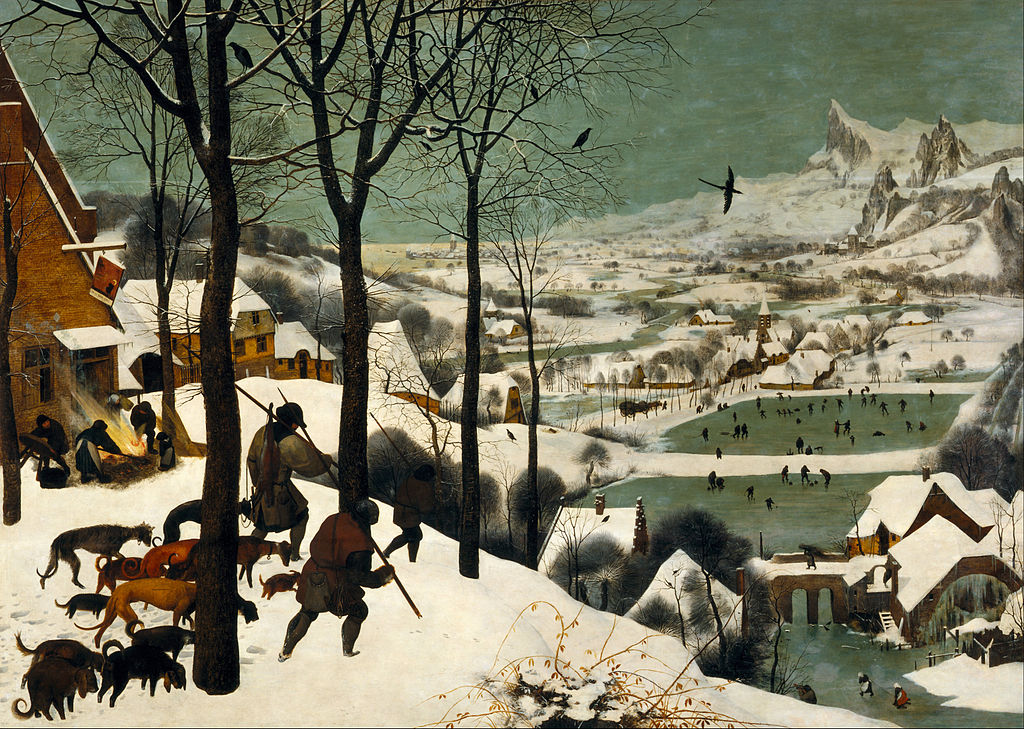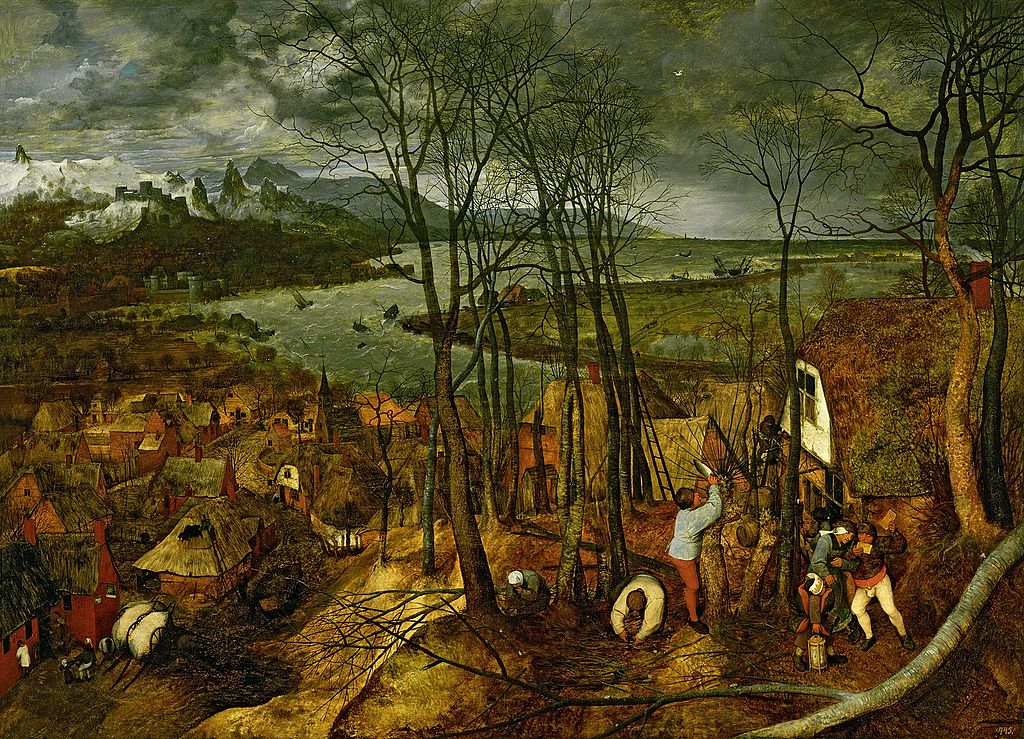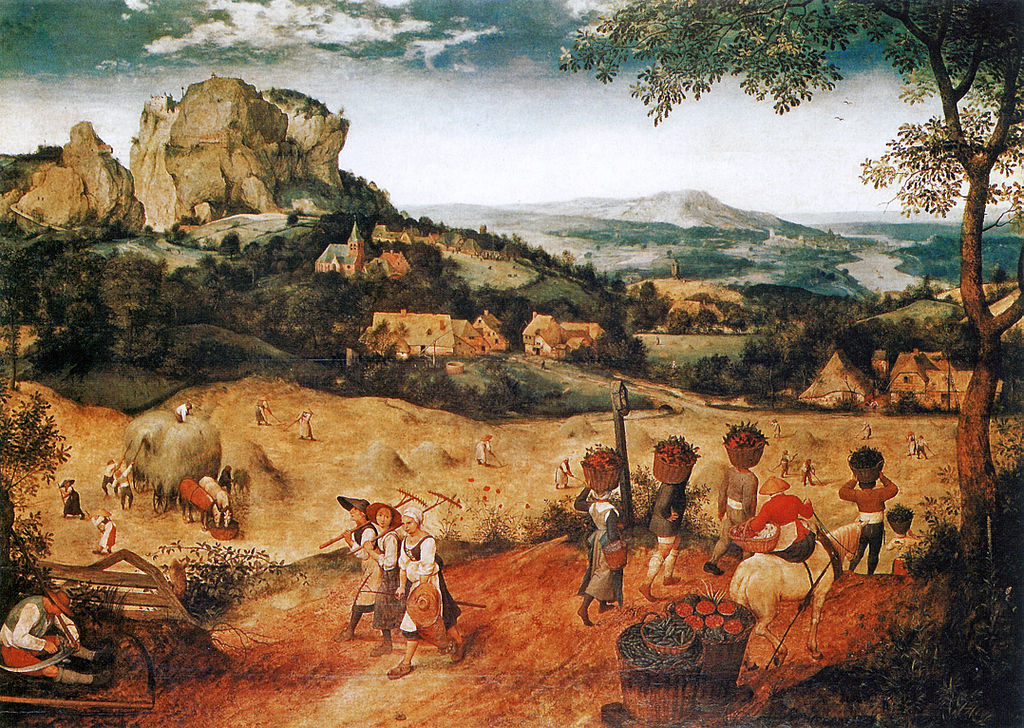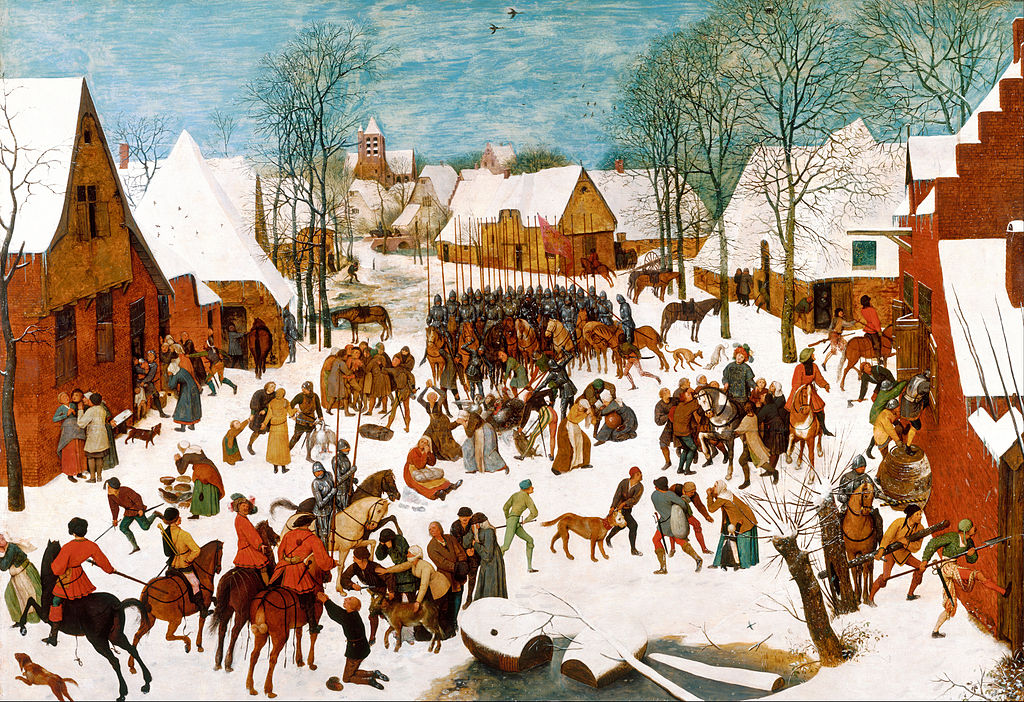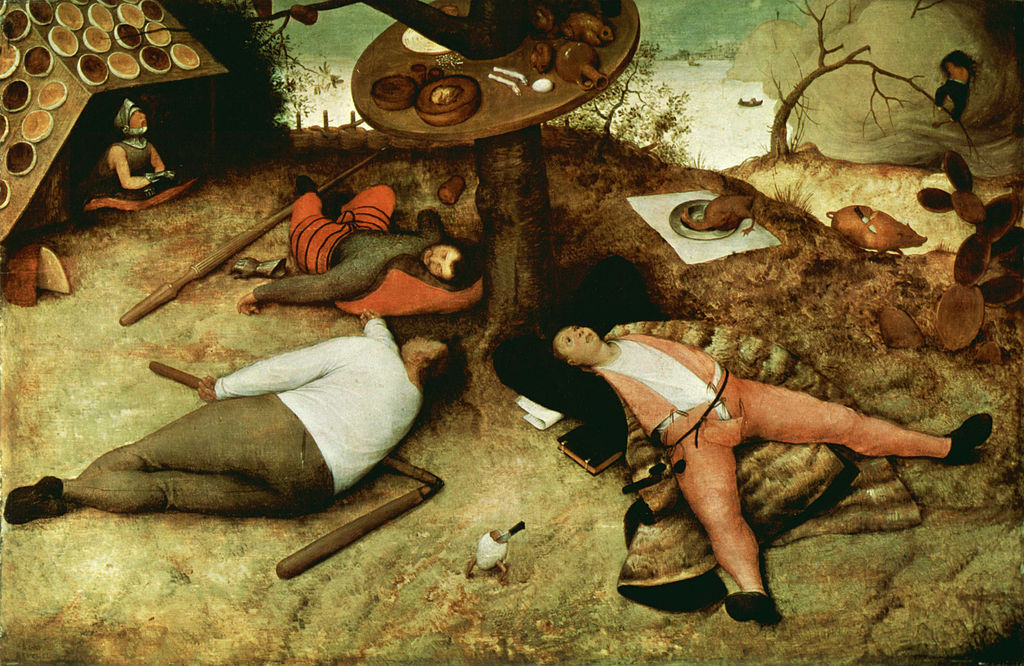|
Where? Room X on the First Floor of the Kunsthistorisches Museum
When? 1565 Commissioned by? Niclaes Jongelinck, a Belgian art collector and banker. What do you see? In the left foreground, a group of peasant hunters and their dogs trudge through heavy snow as they return home from a search for food. It looks like their day was largely unsuccessful as only one hunter carries the cadaver of a small fox, and the dogs look somewhat underfed. Slowly, they pass by a group of villagers roasting corn over a fire at the inn on the far left. The sign hanging above the inn falls lopsided, skewed, maybe by the wind. In front of the hunters are the footprints of a small animal, perhaps a rabbit that has escaped them. The dogs continue sniffing at the ground in the hopes of finding it. The hunters can already see their village. Tiny figures and silhouettes are scattered across the frozen waters as they play curling, hockey, and skate around in groups. Even further behind them are more white and brown houses surrounded by dead trees and black birds, bridges, and pointed towers all dwarfed by the massive snowy mountains that loom over the entire scene. Backstory: Pieter Bruegel the Elder created Hunters in the Snow as part of his series, the Seasons. Bruegel painted scenes of autumn, winter, early spring, early summer, and summer and a sixth painting of spring has not survived. The surviving pieces of this series include: The Gloomy Day, The Harvesters, The Return of the Herd, and The Hay Harvest. Two of these paintings are in the Kunsthistorisches Museum in Vienna, one is in Prague, and the last painting is in the Metropolitan Museum of Art. The six part series once included a painting of spring that was lost. The Seasons were commissioned for the dining room of Nicolaes Jonghelinck, a wealthy merchant and art collector from Antwerp. It’s likely that the paintings were spread out as a frieze on all four walls of the room, creating an immersive experience for the viewer. Hunters in the Snow is Bruegel’s depiction of winter. As with all his pieces, Bruegel packs each of his works with such great detail that many of the miniature scenes he creates are impossible to see with the naked eye. With these details, he crafts a realistic and immersive scene that draws viewers in and plants them into a familiar but fantastical world. Much of his work is concerned with the life of the peasant whom he respected. He gave viewers a look into the parts of their daily life.
Who is Bruegel the Elder? Pieter Bruegel the Elder was a Dutch painter who was born near Breda in 1525. Bruegel began his art career in 1555 at the Antwerp School of Art, where he created many engravings, mostly on the topic of sin, learning from the style of Hieronymous Bosch. In 1563, Bruegel left Antwerp and moved to Brussels where he would remain until his death. During this time, Bruegel began to paint more, creating his Seasons series as well as his Massacre of the Innocents in the Royal Collection in London. Much of his work was focused on day-to-day life and reality, standing in contrast to the Renaissance movement in Italy during this time.
Towards the end of his life, Bruegel painted in a “large-figure” style that sought to imitate the rhythm of dance. Works in this style include his The Blind Leading the Blind and The Land of Cockaigne. His attention to reality and detail made him one of the world’s first truly modern painters. Bruegel died in Brussels in 1569.  Detail of hunter shooting birds Detail of hunter shooting birds
Fun fact: Bruegel the Elder incorporated many details in his paintings, something that was characteristic of the Northern Renaissance style. A century before, Jan van Eyck had started this style. But Bruegel took this to another level. Some of these details can barely be seen with the naked eye. One of these includes a little hunter with a rifle shooting at some birds on the right side of the painting. With these minuscule details, Bruegel is able to create a world full of depth and truth.
Written by Sabrina Tian
References:
0 Comments
Leave a Reply. |
Categories
All
|
- Home
- Blog
-
Museums
- Alte Pinakothek
- Art Institute of Chicago
- Baltimore Museum of Art
- Barber Institute of Fine Arts
- Bargello
- Barnes Foundation
- British Museum
- Church of Sant’Anastasia
- Cleveland Museum of Art
- Courtauld Institute of Art
- Detroit Institute of Arts
- Frans Hals Museum
- Galleria Borghese
- Gallerie dell'Accademia
- Getty Museum
- Guggenheim
- Hermitage Museum
- Kunsthistorisches Museum
- Kunstmuseum Basel
- Legion of Honor Museum
- Louvre
- Mauritshuis
- Metropolitan Museum of Art
- Musee d’Orsay
- Museum of Fine Arts in Boston
- Museum of Modern Art
- National Gallery in London
- National Gallery of Art
- National Museum in Poznań
- Norton Simon Museum
- Ny Carlsberg Glyptotek
- Palace of Versailles
- Palazzo Pitti
- Palazzo Vecchio
- Petit Palais
- Philadelphia Museum of Art
- Prado
- Pushkin Museum
- Ravenna Art Museum
- Rijksmuseum
- San Diego Museum of Art
- Santa Maria delle Grazie
- St. Peter's Basilica
- Städel Museum
- Statens Museum for Kunst
- Tate Britain
- Tate Modern
- Timken Museum of Art
- Uffizi
- Vatican Museums
- Wallace Collection
-
Artists
- Altdorfer
- Anguissola
- Berlin Painter
- Bosch
- Botticelli
- Boucher
- Bronzino
- Bruegel the Elder
- Brunelleschi
- Cabanel
- Caillebotte
- Canova
- Caravaggio
- Carpeaux
- Cezanne
- Cimabue
- David
- Degas
- Delacroix
- De Maria
- Donatello
- El Greco
- Fontana
- Fra Angelico
- Fragonard
- Gauguin
- Gentileschi
- Gericault
- Gonzalez-Torres
- Goya
- Hals
- Hogarth
- Hokusai
- Ingres
- Leonardo da Vinci
- Lippi, Filippo
- Longhi, Barbara
- Lorrain
- Makovsky
- Manet
- Massys
- Matisse
- Merian
- Michelangelo
- Mochi
- Modigliani
- Monet
- Panini
- Parmigianino
- Perugino
- Picasso
- Pisanello
- Raphael
- Rembrandt
- Renoir
- Reynolds
- Rivera
- Rodin
- Rubens
- Scultori
- Seurat
- Steen
- Tintoretto
- Titian
- Toulouse-Lautrec
- Turner
- Uccello
- Van der Weyden
- Van Dyck
- Van Eyck
- Van Gogh
- Van Hemessen
- Vasari
- Velazquez
- Vermeer
- Veronese
- Vigée Le Brun
-
Locations
- Books
- About Us

